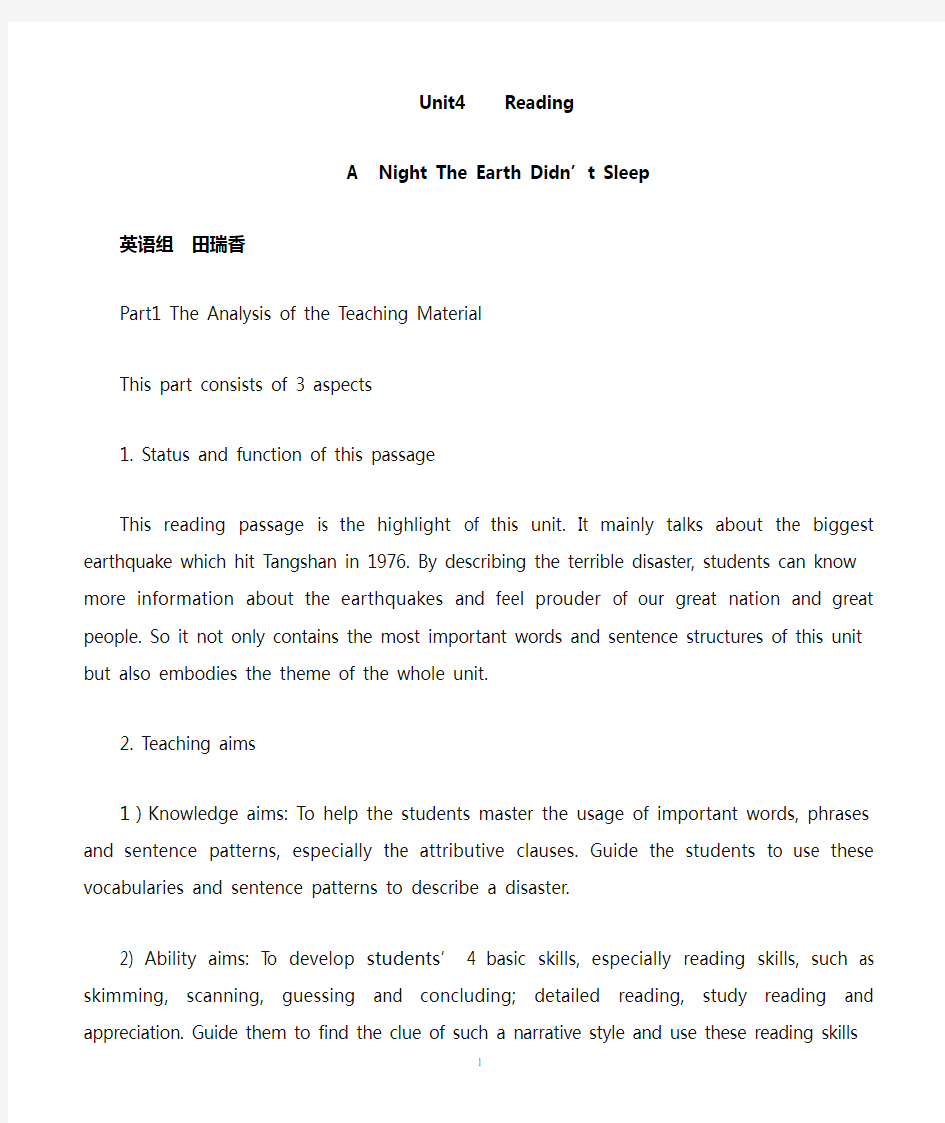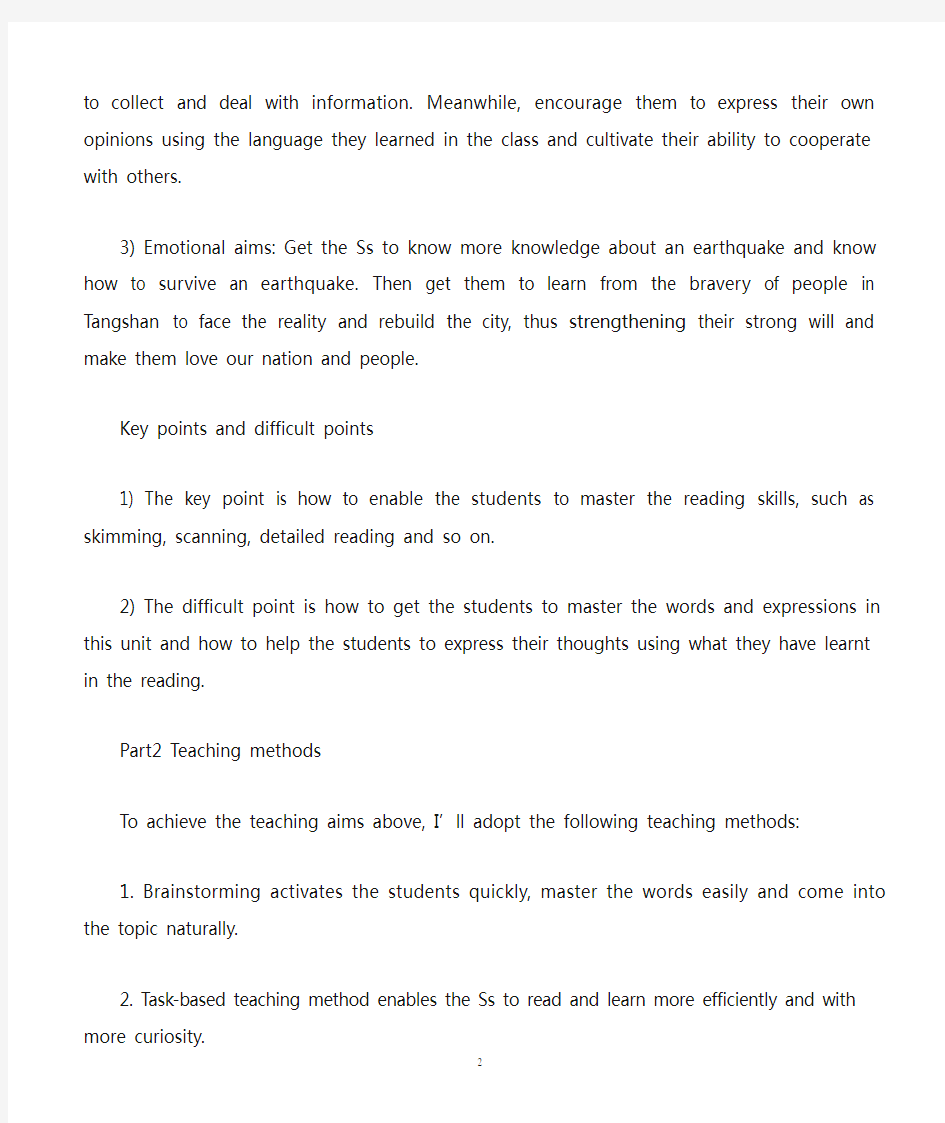Unit4 Reading 说课稿


Unit4 Reading
A Night The Earth Didn’t Sleep
英语组田瑞香
Part1 The Analysis of the Teaching Material
This part consists of 3 aspects
1. Status and function of this passage
This reading passage is the highlight of this unit. It mainly talks about the biggest earthquake which hit Tangshan in 1976. By describing the terrible disaster, students can know more information about the earthquakes and feel prouder of our great nation and great people. So it not only contains the most important words and sentence structures of this unit but also embodies the theme of the whole unit.
2. Teaching aims
1)Knowledge aims: To help the students master the usage of important words, phrases and sentence patterns, especially the attributive clauses. Guide the students to use these vocabularies and sentence patterns to describe a disaster.
2) Ability aims: To develop students’ 4 basic skills, especially reading skills, such as skimming, scanning, guessing and concluding; detailed reading, study reading and appreciation. Guide them to find the clue of such a narrative style and use these reading skills to collect and deal with information. Meanwhile, encourage them to express their own opinions using the language they learned in the class and cultivate their ability to cooperate with others.
3) Emotional aims: Get the Ss to know more knowledge about an earthquake and know how to survive an earthquake. Then get them to learn from the bravery of people in Tangshan to face the reality and rebuild the city, thus strengthening their strong will and make them love our nation and people.
Key points and difficult points
1) The key point is how to enable the students to master the reading skills, such as skimming, scanning, detailed reading and so on.
2) The difficult point is how to get the students to master the words and expressions in this unit and how to help the students to express their thoughts using what they have learnt in the reading.
Part2 Teaching methods
To achieve the teaching aims above, I’ll adopt the following teaching methods:
1. Brainstorming activates the students quickly, master the words easily and come into the topic naturally.
2. Task-based teaching method enables the Ss to read and learn more efficiently and with more curiosity.
3. Situational approach enables the students to be active and creative.
4. Multi-media assistance arouses the students’ interest, curiosity and desire for learning.
Part3 Learning Methods
As is described in modern educational theory, “the process of obtain ing knowledge is more important than obtaining knowledge itself”, so I will try to arouse the students’ potentia l and make them obtain knowledge by way of autonomous study and cooperation, and at the same time form good learning methods to improve their reading, speaking, and writing abilities.
Part4 Teaching procedures;
According to the teaching aims, I divide the teaching procedures into 3steps, that is warming up and pre-reading, while-reading and post-reading.
Step1 Warming-up and pre-reading (It includes 2tasks)
Task1: Get the students to discuss in groups about the warming-up, encourage them to imagine bravely and describe the damage to these beautiful and calm buildings after the earthquake.
Task2: Discuss the 2 questions in pre-reading part and report their result to the whole class.
The purpose of this step is to revise some words and enrich the students’ background knowledge about earthquakes by brainstorming.
Step2 While-reading (This step includes 4 tasks)
Task1 skimming
Skim the passage and do some true or false questions.
The purpose is to enable the students to find out some exact information quickly. The students can also combine their background knowledge they got in pre-reading with detailed information.
Task2 Scanning
Scan the passage and do exx.2 by individual work and pair work. Meanwhile get the students to find out the main idea of each paragraph.
The purpose is to enable the students to find out the clue of this text and understand the structure of this passage.
Task3 Study reading
Get the students to read and study the passage to find out the difficult and charming sentences and then try to analyze and memorize them.
The purpose is to train the students’ ability of understanding, appreciating and using language. Task4 Listening and reading aloud
Now that the students have fully understood the whole passage, I will get them to listen to the tape and read it aloud to prepare for the next step: post-reading.
Step3 post reading (It includes 2tasks)
Task1 Writing
Get the students to write a summary of this passage, using the useful expressions and sentence patterns they have learnt in this unit.
Task2 Acting out an interview
Get the students to act out an interview between a reporter and a survivor from the Tangshan earthquake. One student acts as a reporter, and the other acts as a reporter.
The purpose of this step is to consolidate the students’ language knowledge and language ability, and at the same time to broaden the students’ cultural awareness.
Step4 Homework
Finish off the reading task on workbook and preview the tasks in learning about language.
Part 5 Teaching assessment (It includes 4 aspects)
1. Self-assessment
2. The group members’ assessment
3. The teacher’s assessment
4. Speaking assessment
Part 6. Blackboard design and time division
1. Blackboard design:
1) Key words and sentences
2) Questions for reading
3) The main idea for each paragraph.
2. Time division
Warming up and pre-reading: 8 minutes While-reading: 25 minutes
Post-reading: 12 minutes.
Part7. Reflection after class
在平时的教学过程中,我们对每个单元的教学不是完全按照教参的要求来处理的,由于我们学生水平有限,课文中的听力及写作部分我们是基本跳过,而另外选取适合我们学生的材料来训练他们的听力及写作,在高一我们着重训练学生的造句能力。阅读课文是我们教学的重点,根据各单元阅读课文的题材、体裁特点,我们设计了不同的教学活动及练习去训练及培养学生的阅读能力。我们选取阅读课文The Night The Earth Didn’t Sleep,设计了两个课时的教学学案。我们在设计第一个课时- 阅读课时,根据六级的目标定制了本阅读课基本的技能:略读(skimming);细读(close reading);总结、归纳内容的能力(summarizing)、了解重点细节。第二个课时–词汇学习(Learning about language),我们设计不同的练习强化学生对重点词汇的印象,最终达到运用所学词汇写出一段有关地震的短文,掌握地震相关的词汇表达。
在设计教案和课件的过程中,我们想尽量让学生多了解地震的情况及如何使学生对灾难有正确的认识,要用积极的态度来对待它,因此选取两段视频:一是汶川地震的100个瞬间,二是earthquake;但在课堂教学时我们发现,由于“汶川地震的100个瞬间”这段视频时间长达8分40秒,如果在课堂上播放完整的视频会占用过多的时间,我们建议老师们在课前就开始播放,作为引入而节省时间或是播放部分的视频,情况视学生的基础而定。
在第一课时- 阅读课中有以下这个练习:
1.Read again and divide the passage into three parts and match them with the main ideas.
Paragraph Main idea
1)Part one (before the earthquake):_________ A. damages
2)Part two(during the earthquake):_________ B. rescue
3)Part three(after the earthquake):_________ C. signs
因为我们学生的基础及词汇量非常有限,我们根据篇章结构而设计这个练习,对于较好的学生来讲,老师们完全可以把main idea的答案删掉,而让学生自己去分段和找出main idea of each paragraph.
为了让学生更好地掌握文章的细节,我们设计了Find out the Datas(数据)and fill in the blanks这一练习让学生通过找出具体数据真切地感受到唐山大地震的所造成的可怕灾难。在课堂上学生们很快能就找到答案,这有助提高他们阅读的兴趣,兴趣是学习最好的动力。
第二个课时–词汇学习中的I. Vocabulary building 和II. Fill in the blanks with the correct words这两题在我们平时的教学过程中是非常重要的一个环节。我们学生的词汇量很有限,因此我们希望通过坚持不懈的努力让学生的词汇量丰富起来,为将来的高考打下良好的基础。对于这部分的练习,我们通常是在上完第一个阅读课后就把练习卷发给学生当作业,第二节课时就可以节省时间来做造句练习。
对于最后的一个练习- IV. Write a short passage according to the following information的处理可以根据学生的基础及课堂教学的实际情况而定,程度好的学生应该可以在一节课内完成该题的翻译,程度较弱的则可以把这一题留作课后作业。设计这个练习的目的是让学生掌握好本课的重点词组,并通过翻译、造句而学会运用这些词组及表达法。
